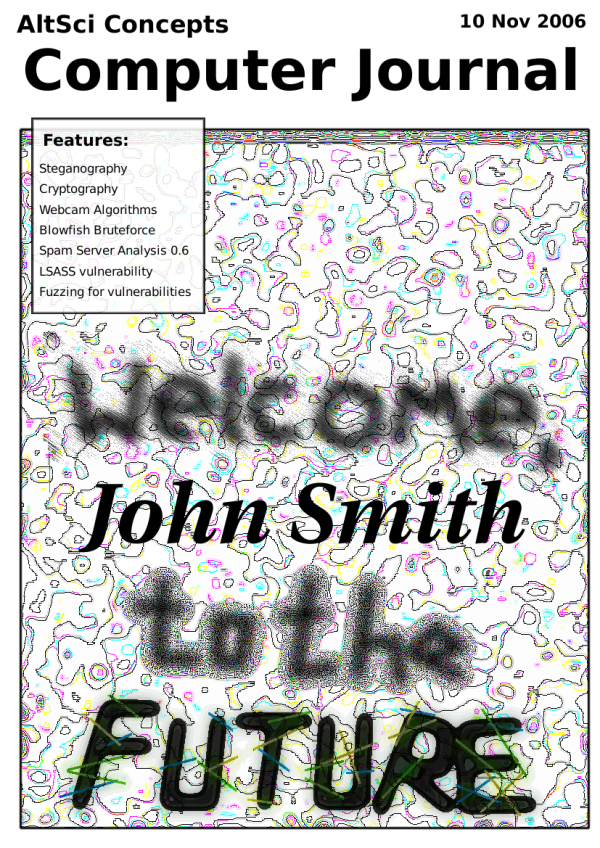by Javantea aka. Joel R. Voss
Nov 9-10, 2006
AI Coder 1 version 0.1 Source
[sig]
Scripting languages have become an important part of programming functionality. Often, scripting languages are run in a sandbox with a specific piece of memory available and all code interpreted by a program written to execute only a subset of the computer's functionality. This has allowed a system on the web where client-based code can be run on the clients for quick reaction time and specific features. Most of the actual code (data retrieval, calculation, and storage) needs to be run on the server, so it leaves the client code to be nearly all real-time display. In fact, most webpages need no actual client-side code to be perfectly functional. However, more and more sites are relying on increasingly complex scripting libraries including AJAX, math, and data handling. Running a SHA1 hash on a client-side may be useful for many purposes, but many problems arise with these systems.
Browsers must handle a large amount of useful script as well as a large amount of invalid script without detracting from user experience. Compliance with standards is also an important factor in writing a browser. With these factors in mind, obvious security questions arise. Many of these have been addressed by browser developers, yet many have not. Javascript is obviously headed to be the leading cause of DoS if it is not already. It has also become a major threat to user privacy due to Cross-site scripting (XSS) attacks as well as malicious phishing attacks.
Read more »BitTorrent Protocol Attack
by Joel R. Voss aka. Javantea
jvoss@altsci.com
jvoss@myuw.net
Feb 23-26, 2005
BitTorrent Attack 0.3 Source
[sig]
BitTorrent Attack 0.2 Source
[sig]
Official BitTorrent Protocol
Official BitTorrent Client
Netmap2 Page
The BitTorrent Attack is a small project to see what we can do with the BitTorrent protocol without sending or receiving legitimate data. It is part of Netmap2 (aka. Protocols and Services Project).
Read more »
by Javantea
Oct 10, 2006

An image is a simple representation of a complex system in the same way that a program is a simple representation of a business. These similarities are hand in hand in the creation of programs and images as well as the viewing. Viewing an image is very much like using a program and reverse engineering a program is quite similar to analysing an image. The concepts are much easier for non-programmers to understand in terms of art, so to discuss programs, I will first discuss art. For programmers, the concepts are much easier to understand in terms of a program, so to discuss silly images, I will then discuss programs.
First, I will discuss the image which I enjoyed so very much creating and which I enjoy so very much discussing. The background is a favorite technique of mine. It is discussed in great detail below. It represents the sea of random information in cyberspace that users swim through daily. The colors are bright like the virtual neon signs that plague every corner of the internet. Each line of text was created using a different technique. Motion blur on the word welcome represents how quickly the user glances past any piece of data that they are not interested in. John Smith is set in the Times font that all generic 'legit' websites use to lull customers into a false sense of security. The words "to the" use another fun technique (blur, sharpen 99 twice) that I use often (same as the background). This effect represents the repetitive fawning and disillusionment that the technolust lifestyle commonly generates amongst its users. The word "Future" is written with two futuristic features ((blur(f) - f) & hue(f)) that I designed specifically for this image. These features remind me how much of the future is ubiquitous and how little of it really seems Sci-Fi. The phrase "Welcome, John Smith to the FUTURE" is a parody of the common phrase used to greet users when they login. Welcoming someone to the future is a derogatory phrase and is quite akin to telling someone that they're a cave dweller. The second meaning is that most people will be seeing someone else's login page (considering how few John Smiths will be reading this page). This is a common occurrence for hackers and often brings a great feeling of accomplishment, which might be lost on readers who aren't hackers. There is yet another meaning in the phrase and that is the inspiration of the phrase is the song "Cities of the Future" by Infected Mushroom. The design of the song invokes a feeling of power and electricity. The main vocal is modified to be very electric and warbly like the lead synth. I originally created the image as a 1024x768 (for no good reason), which had to be expanded and then shrunk. But it makes a fine background image if you'd like. There you have it, a complete discussion of a mediocre piece of art.
A program can be made simple or complex. A program's reliability depends on how well it has been properly debugged. Debugging depends on hours looking at inane code, which coders often dislike. A program that is built simply is simply debugged. Therefore, the building of many simple programs each of which are easily debugged makes for a better operating environment than having a few large programs.
Read more »




